Exploring the Relationship Between Ultimate Spider-Man and Moon Knight
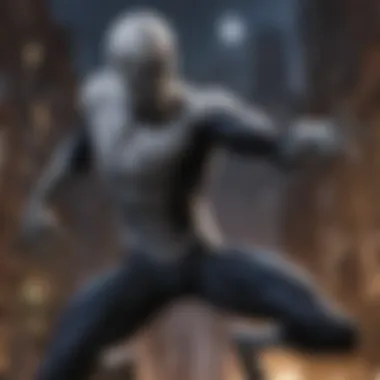
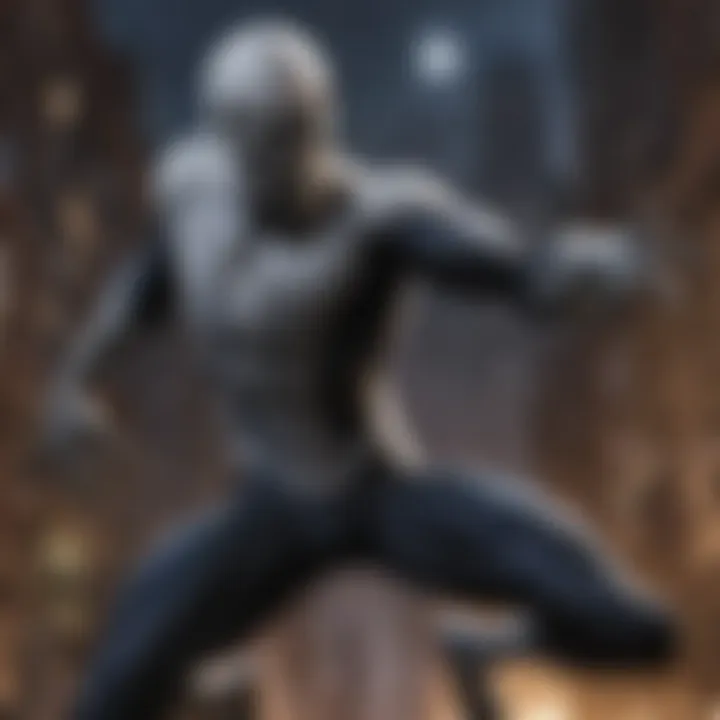
Intro
In the expansive universe of comic books, few pairs are as compelling yet contrasting as Ultimate Spider-Man and Moon Knight. Each character, with their unique attributes and backgrounds, intertwines within the bustling tapestry of the Marvel franchise. The charm of Ultimate Spider-Man lies in the youthful exuberance of Peter Parker, while Moon Knight offers a darker perspective, steeped in complexity and ambiguity. This article aims to explore their distinct origins, their development over time, and the thematic threads that connect them, revealing their interdependence within the larger Spider-Man universe.
By delving into their individual narratives, we can better appreciate the nuanced storytelling that makes contemporary comic book literature compelling. Together, they serve not just as heroes on their respective paths, but as archetypes reflecting broader themes of struggle, identity, and heroism—a microcosm of what defines the superhero genre.
Spider-Man Character Analysis
Background
Spider-Man's origin story is ingrained in the cultural fabric of comic book lore. Born as Peter Parker, a New York City teenager, he enjoys a quiet life until a fateful encounter with a radioactive spider changes everything. This transformation grants him extraordinary abilities, such as enhanced strength, agility, and a sixth sense known as the "spider-sense". As he navigates high school, family loss, and newfound power, Peter grapples with the weight of responsibility, encapsulated in the iconic line: "With great power comes great responsibility."
The evolution of Spider-Man has witnessed various iterations across timelines and universes, notably the Ultimate Universe—a modern retelling aimed at updating his story for newer fans. Here, Peter Parker is a bit more relatable; grappling with teenage angst while tackling supervillains, which makes the character more grounded yet still aspirational.
Powers and Abilities
Ultimate Spider-Man showcases a plethora of powers that set him apart from his peers.
- Agility and Strength: His physical prowess allows him to leap buildings and distance himself from threats at a moment's notice.
- Wall-Crawling: The ability to clamber up vertical surfaces provides him with an advantage against enemies.
- Spider-Sense: This abilities allows him to sense danger before it arrives.
- Web-Slinging: Utilizing web-shooters designed by himself, he swings across New York City with unmatched grace.
Certainly, these abilities not only define his superhero persona but also tie him closely to the city itself, making New York an extension of his identity.
Character Development
The narrative arc of Ultimate Spider-Man is rich in character growth. Key moments punctuate his journey:
- The Death of Uncle Ben: This pivotal event serves as a catalyst, shaping Peter's sense of obligation.
- Fighting Boyd and the Ultimatum: Every hero has battles that test their morals, and facing Boyd forces Peter to confront what kind of hero he wants to be.
- Becoming the Ultimate Version of Himself: Through self-discovery and mentorship, Peter evolves from a boy into a man, understanding that heroism is not just about powers, but choices and sacrifices.
Each of these experiences not only adds depth but also highlights the intricate dance of heroism and humanity, which is central to his story.
Moon Knight Character Analysis
While Spider-Man's bright optimism and youthful perspective resonate with many, Moon Knight brings forth a stark contrast characterized by complexity and shades of gray.
Background
Moon Knight, also known as Marc Spector, is a former mercenary who grapples with multiple identities due to his dissociative identity disorder. His journey begins in Egypt, where he encounters the moon god Khonshu. Resurrected and imbued with form of mystical power, he rotates through various identities, such as Steven Grant, a millionaire, and Jake Lockley, a cab driver. The challenge of navigating these identities adds a compelling psychological dimension to his character, broadening the typical superhero narrative.
Powers and Abilities
Unlike Spider-Man’s capabilities rooted in physical prowess, Moon Knight's abilities stem from his complex mental state and ties to the lunar deity:
- Enhanced Physical Abilities: Guided by the moon, his strength and agility can amplify during nighttime.
- Skilled Combatant: His training as a mercenary comes into play, making him deadly in hand-to-hand combat.
- Multiple Identities: Each persona offers different skills, giving him versatility in tackling challenges.
Character Development
The evolution of Moon Knight is nothing short of intricate:
- Struggles with Identity: His battle against the realities of his mental illness adds a unique layer, prompting readers to explore the definition of heroism in the face of vulnerability.
- The Influence of Khonshu: The relationship with the god shapes his decisions and moral compass, often leading to conflicts within himself.
- Redemption Arcs: Throughout his journey, Marc Spector strives for redemption, questioning not just his actions but also what it means to be a hero with multiple facades.
Their narratives, while different, mirror each other in certain ways—both characters face challenges not just external, but internal, making them relatable on a human level.
Prolusion to Ultimate Spider-Man and Moon Knight
The journey into the worlds of Ultimate Spider-Man and Moon Knight offers a unique lens through which fans can appreciate the complexity of modern storytelling within the superhero genre. Both characters initiate from different poles—the friendly neighborhood Spider-Man, embodying youthful exuberance and responsibility; and Moon Knight, a tormented vigilante wrestling with inner demons and a fractured psyche. By analyzing their interplay, one could see not just their individual growth but also how their narratives reflect broader themes prevalent in society.
Understanding this dynamic relationship is crucial because it sheds light on how comic book creators weave intricate stories that resonate with readers on multiple levels. The impact of these characters transcends typical escapism, prompting discussions about morality, justice, and the human condition. As we dissect their journeys, we also acknowledge the cultural dialogues they inspire, captivating audiences of all ages.
Overview of the Characters
Ultimate Spider-Man, often recognized as a modern reimagining of Peter Parker’s origin, showcases a young man grappling with the burdens of being a hero while trying to maintain a semblance of normality. His character represents not just the challenges of adolescence but also the universal theme of responsibility. In contrast, Moon Knight, or Marc Spector, is frequently viewed as a stark reflection of chaotic morality. His background as an ex-mercenary, combined with his psychological struggles, creates a character that many interpret as an exploration into the realms of sanity and madness.
The encapsulation of these diverse personas provides a rich tapestry for analysis, revealing not just their differences, but the ways in which they complement and challenge one another in stories.
Significance in the Marvel Universe
In the vast universe of Marvel Comics, both Ultimate Spider-Man and Moon Knight carve a niche that contributes to the larger narrative landscape. Spider-Man, particularly in his ultimate form, resonates with themes of hope and the struggles of youth. He remains one of the most relatable superheroes, frequently navigating the highs and lows of teenage life while facing extraordinary challenges.
On the other hand, Moon Knight’s significance stems from his atypical portrayal of justice. Unlike many superheroes who operate under a set moral code, Moon Knight's actions are driven by his complex personality and external influences, including his connection to the Egyptian moon god Khonshu. This adds layers of richness to the Marvel narrative, introducing elements of psychological thriller intertwined with supernatural themes.
Through their stories, both characters push the envelope of traditional superhero literature, allowing for discussions that delve deeper than looming villains and epic battles. They pose questions about identity, ethics, and the very nature of heroism itself, thus solidifying their places in the hearts and minds of fans.
The Genesis of Ultimate Spider-Man
The creation of Ultimate Spider-Man marked a significant pivot in the portrayal of one of Marvel's most beloved characters, Spider-Man. This section investigates the origins of Ultimate Spider-Man, providing context for how this iteration differs from its predecessors while retaining key themes. The inception of this character in the early 2000s reflects an attempt by Marvel to rejuvenate Spider-Man's relevance for both new readers and long-time fans. To understand the character fully, it's essential to look at the initial concept, the pivotal story arcs that defined him, and the transformation of Peter Parker into a more relatable figure.
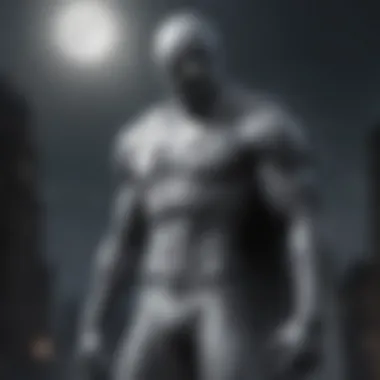
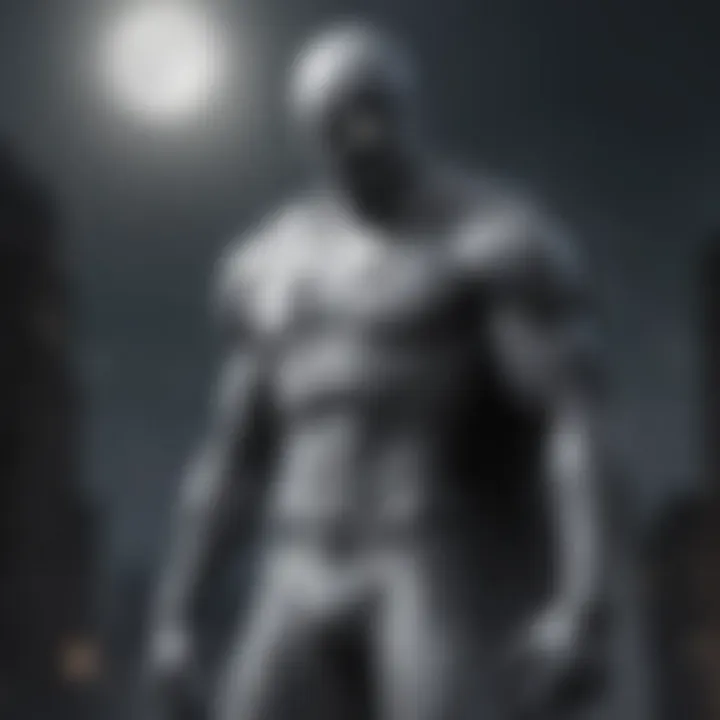
Initial Creation and Concept
When Ultimate Spider-Man was introduced in 2000, writers Brian Michael Bendis and artist Mark Bagley aimed for a fresh take on Peter Parker's narrative. They crafted this series within the Ultimate Marvel Universe, an alternate reality designed to attract younger audiences. The emerging tech age and changing cultural backdrop influenced the character's creation. In this fresh universe, the roots of Spider-Man remain similar, featuring Peter Parker bitten by a radioactive spider, but the storytelling was remarkably updated.
Compared to the original Spider-Man continuity, this version delves into modern issues facing teens, such as cyberbullying, technology dependence, and the complexities of teenage relationships. This not only made Spider-Man relatable to the audience of the 21st century, but it also revitalized a character sometimes seen as stuck in a bygone era.
Key Story Arcs
The journey of Ultimate Spider-Man is punctuated by several key story arcs that highlight both growth and conflict. These arcs dive into not just the action-packed battles typical of superhero narratives, but they also examine the emotional and psychological depths of Peter as a young man navigating adolescence.
- The Night Gwen Stacy Died - This arc explores the tragic loss of Gwen, showcasing Peter Parker's vulnerability when faced with grief and guilt. It prompts a deeper look at the responsibilities that come with superheroism.
- Ultimate Clone Saga - The introduction of clones questions identity and the moral implications of playing with life. Peter's struggle with clones pushes him toward self-discovery, emphasizing how relationships can fundamentally change one's perspective.
- Spider-Verse - This storyline includes numerous Spider-People from parallel universes, highlighting diversity and the broader implications of Spider-Man’s ethos. It enriches the narrative by showcasing different lives and choices shaped by similar circumstances.
Through these arcs, readers see layers of Peter Parker being peeled back, revealing not just a hero but a deeply flawed individual striving for acceptance while battling external foes.
Character Development of Peter Parker
Peter Parker's character evolution in Ultimate Spider-Man stands as an intricate tapestry woven through trials, missteps, and triumphs. Unlike his earlier iterations, this young man is shown grappling with contemporary issues like technology's impact on human connection and the challenge of fitting in a society that both idolizes and ostracizes him.
His character is often deciphered through his relationships. For instance, his bond with Aunt May becomes more central, showcasing a nurturing influence that provides emotional grounding when a young Peter is often lost in his dual life.
Furthermore, issues of confidence and fear surface when he has to face both personal demons and supervillains. The series accentuates that while Spider-Man embodies great power, he also bears great responsibility—this is a theme that resonates deeply throughout the saga.
In essence, the character development in Ultimate Spider-Man places a spotlight on the age-old battle between destiny and choice, making Peter Parker a thoroughly realized and relatable character. This grounding in realism is part of what makes the Ultimate Spider-Man universe resonate, giving fans a chance to connect with him on a much deeper level than we’ve seen in previous adaptations.
The Emergence of Moon Knight
The arrival of Moon Knight in the world of comics marked a significant shift in the portrayal of superhero characters. Focusing on themes of identity, trauma, and the dichotomy of perspective, Moon Knight is not just another vigilante; he embodies complex layers of psychological depth. In an era where superheroes often represented straightforward ideals and moral clarity, Moon Knight challenged the norms, introducing a character who grapples with mental illness and the consequences of his actions. Understanding the emergence of Moon Knight provides insight into how he parallels, complements, and occasionally contrasts with the ethos of Ultimate Spider-Man.
Creation and Background
Moon Knight was created by writer Doug Moench and artist Don Perlin, making his first appearance in "Werewolf by Night" #32 in 1975. The idea was to introduce a character who would embody the struggles of a man with multiple identities, playing into the broader themes of duality. The original intent was to develop a character who could shift between hero and anti-hero, reflecting the darker tones emerging in comic storytelling at the time. His origin as Marc Spector, a mercenary who becomes an avatar for the Egyptian moon god Khonshu, entails a fascinating blend of mythology and street-level heroism.
Throughout the years, Moon Knight has been reinterpreted through different lenses, each time revealing hidden facets of his persona. For instance, early issues highlight his role as a mercenary, while later interpretations hone in on his psychological conflicts and moral ambiguity. This duality makes him a perfect foil to Ultimate Spider-Man, who often embodies youthful optimism even while confronting serious topics.
Narrative Style and Themes
The narrative style of Moon Knight is distinctive, often characterized by its exploration of psychological themes. Stories tend to oscillate between reality and Marc Spector's fragmented perceptions, drawing readers into a world where the boundary between sanity and insanity blurs. Moon Knight's narratives frequently employ unreliable narrators, which leads to a greater exploration of identity and purpose. Readers see Spector battling external enemies as well as the internal demons of his fragmented psyche.
Rather than adhering to a traditional hero's journey, the stories challenge the very nature of heroism. Moon Knight asks profound questions: What constitutes justice? How much solice can a person find in vengeance? This inquiry aligns interestingly with the struggles faced by Peter Parker in Ultimate Spider-Man, who constantly juggles his responsibilities as a hero with the complexities of adolescence.
Duality of Character: Marc Spector
The concept of duality in Marc Spector's character does not merely stay on the surface; it informs his actions and choices throughout his stories. Spector embodies multiple identities: a mercenary, a street-level vigilante, and a divine protector under Khonshu. This multifaceted persona brings up important discussions about self-identity and the masks we wear, literally and figuratively.
Moon Knight's struggle with dissociative identity disorder adds another layer to this duality, compelling readers to question the very essence of who he is. Each identity serves a particular purpose, reflecting his struggle and the harsh realities of life in a brutal world. When compared to Peter Parker, who often fetters himself with guilt and obligation, Marc shows a complex array of choices and consequences that maintain the reader's engagement on deeper psychological levels.
"In the shadows of New York, two heroes navigate their unique journeys, reflecting the chaos, hope, and moral ambiguity we all face."
In summary, the emergence of Moon Knight not only introduced a character brimming with complexity but also transformed the comics landscape. By fostering dialogues on identity and moral ambiguity, Moon Knight stands apart as a character who represents the complexities of human experience while existing within the superhero genre. Understanding his emergence sets the stage for exploring the nuanced interplay between him and Ultimate Spider-Man, underscoring how their paths can converge and diverge in compelling ways.
Character Interactions: Spider-Man Meets Moon Knight
In the vibrant tapestry of the Marvel Universe, the interactions between characters often serve as pivotal moments that highlight contrasting ideologies and illuminate complex relationships. The meeting of Ultimate Spider-Man and Moon Knight is no exception. Their connection unfolds like a well-woven narrative, rich in subtext and laden with thematic weight. This section takes a closer look at how their interactions not only provide insight into their individual characters but also shape the larger comic book narrative.
The importance of this topic stems from several key elements. Firstly, these encounters showcase how vastly different characters can coexist and even collaborate within a shared universe. Secondly, their relationship encapsulates significant themes such as justice, morality, and identity, inviting readers to reflect on deeper philosophical questions. Lastly, understanding their dynamics allows fans to appreciate the layers of storytelling that define contemporary comics, making this interaction a vibrant study of duality and perspective.
First Encounters
The first meetings between Spider-Man and Moon Knight are marked by tension, misunderstanding, and an eventual sense of camaraderie. When these two iconic heroes first crossed paths, it was during a precarious situation in New York City. Spider-Man, known for his youthful exuberance and quips, faced the somber and intense figure of Moon Knight, who arrived on the scene with an ethereal quality.
Their initial encounters were less about forming an alliance and more about clashing due to their differing approaches to justice. Spider-Man, relying on his sense of humor and quick thinking, often found himself confounded by Moon Knight's dark and brooding nature.
- Setting the Stage: Their first meeting could be characterized by a misunderstanding of intent, as Spider-Man might have perceived Moon Knight as a rogue vigilante.
- Symbolism: This dynamic symbolizes the broader conflict between light and dark, a central theme that resonates throughout their stories.
Moon Knight’s complex backstory as a former mercenary grappling with dissociative identity disorder adds a unique layer to their exchanges. In contrast, Spider-Man embodies the quintessential teenage superhero, grappling with the weight of responsibility in a much more traditional sense. Through their interactions, readers witness the fascinating juxtaposition of light-heartedness versus darker introspection.
Conflicts and Alliances
As their relationship evolved, so did the nature of their interactions. Conflicts between Spider-Man and Moon Knight often arose from their divergent moral compasses. Where Spider-Man adhered to a more traditional interpretation of justice, Moon Knight operated under a personal code driven by his connection to Khonshu, the Egyptian god of the moon. This leads to uncommon alliances formed under unusual circumstances.
One notable event highlights the conflict when they confronted a common foe. Their differences came to a head while battling criminals, with Moon Knight’s ruthlessness often contrasting sharply with Spider-Man’s more restrained approach. This led to differing opinions on how best to tackle crime, igniting some heated debates between them.
- Collaboration and Conflict:
- Moon Knight's willingness to employ extreme measures for results often put him at odds with Spider-Man.
- This friction ultimately enriches their relationship, as they learn to harness each other's strengths.
Amidst the rough patches, their collaborations reveal moments of synergy. They discover how their individual skills can complement each other in unexpected ways, leading to thrilling outcomes. Their unique powers blend beautifully during moments when teamwork becomes essential, such as when they face more formidable enemies that require combined efforts.
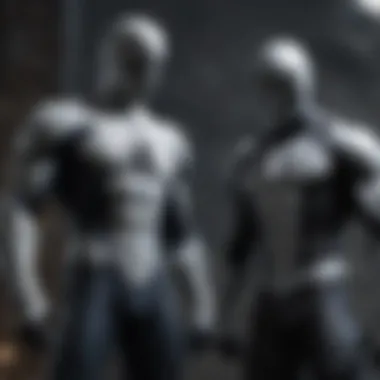
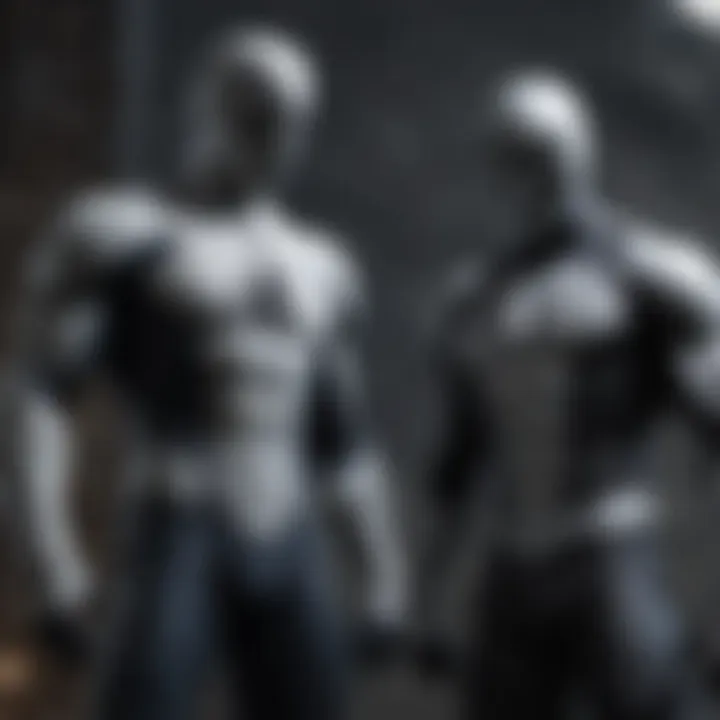
Thematic Exploration
The thematic exploration within the context of Ultimate Spider-Man and Moon Knight uncovers layers that resonate beyond mere storytelling. It serves as a critical lens through which readers can dissect the complexities of heroism, morality, and psychological intricacies embedded in both characters’ journeys. Delving into these themes allows fans and scholars alike to appreciate how such narratives shape and expand the Marvel Universe.
Justice vs. Vigilantism
In the Marvel narrative tapestry, the tension between justice and vigilantism creates a vibrant dialogue around what it means to be a hero. For Ultimate Spider-Man, Peter Parker embodies the youthful idealism often linked with the pursuit of justice through lawful means. He struggles with the weight of responsibility that comes with his powers, symbolizing the hope for a world where good can triumph through order and legality.
On the other hand, Moon Knight presents a stark contrast. Marc Spector operates in the grey areas of morality, often taking the law into his own hands. His brand of vigilantism is rooted in trauma and the quest for redemption, affecting his mental health and how he perceives justice. This duality not only differentiates the two characters but also invites discussion on the effectiveness and ethical implications of their chosen methods.
- Questions arise:
- Can vigilantism ever be justified?
- What happens when the legal system fails to deliver justice?
Ultimately, the exploration of justice and vigilantism is not just about methods but the moral compasses that guide each character's decisions, pulling readers into a reflective consideration of their own beliefs about justice.
Psychological Depth in Characters
The depth of psychological exploration in Ultimate Spider-Man and Moon Knight is striking. Both characters reflect varying aspects of mental struggles, albeit manifested differently. Peter Parker's journey often revolves around anxiety and the burden of dual identities. He symbolizes the common adolescent fears of inadequacy and the pressure of expectations, making him relatable to a wide audience.
On the contrary, Moon Knight delves into a much darker psychological landscape. Marc Spector's dissociative identity disorder shows how trauma can splinter one's psyche, leading to a struggle for coherence amidst chaos. His multiple identities, including Steven Grant and Jake Lockley, each grapple with different facets of his character's core, representing conflicting desires and the relentless pursuit of purpose.
- A thought-provoking insight is that:
"To understand their actions fully, we must first comprehend their mental battles."
This thematic richness further emphasizes how superheroes are not just portrayed as invincible figures but as complex individuals processing multifaceted realities.
Morality and Ethics: A Comparative Study
When delving into the ethics and morality displayed by Ultimate Spider-Man and Moon Knight, a comparative study serves to illuminate the diverging philosophies behind their actions. Spider-Man operates primarily from a moral framework built on power and responsibility, a dictum that guides his every decision. This unwavering principle shapes his identity and underscores his reluctance to cross certain boundaries, such as taking a life.
Moon Knight, however, presents a more chaotic moral landscape. His actions often raise questions about the nature of justice, where his intense need for vengeance blurs ethical lines. His methods—ranging from brutal confrontations to unorthodox decisions—challenge traditional moral structures, provoking readers to reflect on absolute versus relative ethics.
- Some focal points to ponder include:
- Do means justify the ends?
- Is it possible for morality to vary between different contexts?
Overall, the thematic exploration of morality between these characters enriches the lore surrounding them, ultimately offering profound insights into what it means to be a hero.
Artistic Representation and Style
The examination of artistic representation and style in comics not only enhances the readers’ experience but also serves as a critical tool in storytelling. In the context of Ultimate Spider-Man and Moon Knight, the visual elements are far from mere adornments. They actively shape the narrative and contribute significantly to character development and thematic exploration. Understanding the artistic choices behind these characters can lead to a richer comprehension of their stories and the messages they convey.
Visual Aesthetics of Ultimate Spider-Man
In Ultimate Spider-Man, the visual aesthetics are characterized by a vibrant color palette and dynamic action sequences that draw the reader in. The use of bright colors mirrors the youthful energy of Peter Parker. Artists like Mark Bagley in the early issues employed clean lines and exaggerated expressions, making the characters' emotions palpable. The visual representation of Spider-Man, swinging through the skyscrapers of New York, is not just visually appealing; it establishes his place in the city and reflects the duality of his character.
The panels often showcase movement and fluidity, capturing the essence of Spider-Man's agility. Particularly, the scenes where he battles villains—such as the Green Goblin—are meticulously crafted. The intricate details of his web-slinging are meant to exhilarate, immersing the readers in action-filled sequences where the stakes feel incredibly real. The choice of angles and perspectives often conveys emotion effectively. For instance, close-ups during moments of inner conflict or fear provide a connection between Peter Parker and the audience, emphasizing his struggles as a teenager alongside his superhero responsibilities.
Ultimately, the visual approach not only enhances the action but also encapsulates the essence of youthful exuberance and the weight of one's choices—an enduring theme in Ultimate Spider-Man.
Moon Knight’s Iconic Imagery
On the other hand, Moon Knight’s visual representation is distinctive and laden with symbolism. The character is often depicted in stark contrasts, most notably black and white, which reflects his complex personality. The choice of color palette creates an atmosphere that's almost haunting, allowing for a visual exploration of themes related to identity, mental health, and morality.
Dave Finch and later artists like Declan Shalvey utilized shadow and light to create tension and drama in the artwork. Moon Knight's striking mask, which covers his face in stark white, acts as a canvas for his psychological state—emptiness, confusion, and sometimes rage can be conveyed through subtle variations in expression on his mask and body language.
"The artistic choices in Moon Knight are not just about aesthetics; they delve into the psyche of Marc Spector, allowing readers to visually engage with his inner struggles."
Moreover, the way Moon Knight interacts with his environment—whether it's his brutal confrontations with criminals or his meditative moments under the night sky—offers a narrative depth that the visuals cleverly enhance. By portraying Marc Spector’s duality through the artwork, readers can perceive his troubled psyche, visualizing the dichotomy between hero and monster.
In summary, the artistry found in these comics is not merely for show; it brings to life the characters' journeys. The interplay of colors, lines, and symbols encapsulates the emotional weight of their stories, providing a deeper understanding of the worlds they inhabit. Critics and fans alike recognize that the visual storytelling is just as important as the words on the page, assisting in conveying the profound narratives woven throughout both Ultimate Spider-Man and Moon Knight.
Cultural Impact of Ultimate Spider-Man
The cultural significance of Ultimate Spider-Man extends beyond mere storytelling; it touches on societal issues, fosters community, and shapes future narratives in comics. This series redefined the Spider-Man mythos for a new generation, presenting a Peter Parker who resonated with contemporary youth while addressing topics like identity, responsibility, and the pressing challenges of growing up. In this light, it's vital to dissect how this iteration of Spider-Man influenced not only comics but also other media and global pop culture.
Influence on Future Spider-Man Portrayals
The impact of Ultimate Spider-Man on future Spider-Man narratives is undeniable. The series introduced a younger, more relatable Peter Parker, reflecting the ambivalence and aspirations of modern adolescence. This transformation set the stage for future adaptations, including films and animated series that drew inspiration from this more nuanced portrayal. Notably:
- Character Redefinition: Following the lead of Ultimate Spider-Man, later portrayals emphasized Peter's inner struggles, expanding on themes of guilt and heroism.
- Diversity in Storytelling: The comic opened doors to diverse characters within the Spider-Verse, paving the way for series like Spider-Gwen and adaptations that showcase characters like Miles Morales.
- Inclusion of Contemporary Issues: Capturing modern dilemmas such as the pressures of social media or the realities of urban life, future narratives continued the trend of addressing relevant topics, enriching the superhero genre.
Overall, the relational depth depicted in Ultimate Spider-Man has become a gold standard for character development, influencing how creators structure narratives around heroism in subsequent Spider-Man adaptations.
Critical Reception and Legacy
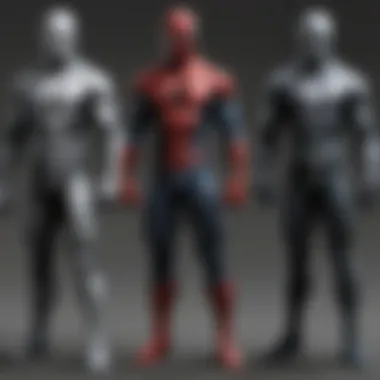
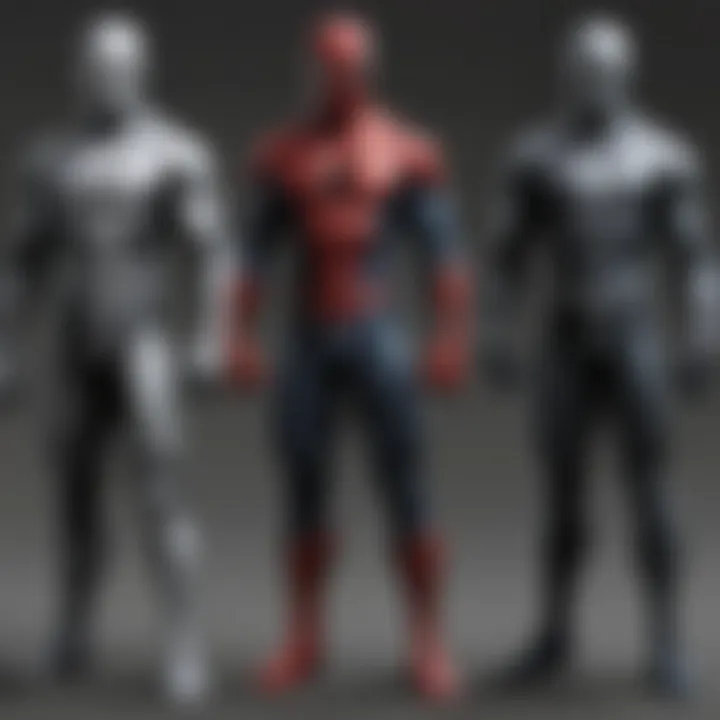
The critical reception of Ultimate Spider-Man has been overwhelmingly positive, leading to a lasting legacy that shaped the comic book landscape. Critics hailed it not just for its youthful approach but also for its brilliant artwork and storytelling techniques. Here are key points that illustrate its impact:
"Ultimate Spider-Man stands out as a benchmark that bridges the gap between classic comic narratives and modern storytelling conventions."
- Awards and Accolades: The series received numerous awards, cementing its status as a critical darling in the realm of graphic literature.
- Fan Engagement: The comic cultivated a vibrant community of fans, leading to conventions and online forums where discussions about character arcs and storylines flourished.
- Lasting Influence on Comics: It inspired other writers and artists, proving that superhero stories can explore multilayered themes without losing their appeal.
In sum, the cultural impact of Ultimate Spider-Man is profound, with its reverberations felt across various forms of media. As Spider-Man continues to evolve, the roots planted by this series will undoubtedly guide its future iterations.
Moon Knight’s Role in Expanding the Marvel Universe
Moon Knight, a character forged in the heart of darkness and drawn from the depths of human experience, contributes a considerable depth to the Marvel Universe. He’s not just a superhero but a complex figure whose journeys have intertwined with many other heroes, expanding the narrative landscape of comics. By embracing themes of mental health, justice, and morality, Moon Knight presents a contrasting ethos to characters like Ultimate Spider-Man. This positions him as a vital player in a universe that thrives on diverse perspectives and unique storytelling.
Crossovers with Other Heroes
Moon Knight’s interactions with a range of heroes spotlight his significance in the expanding Marvel Universe. His unique character arcs often provide new dimensions to otherwise traditional superhero narratives.
- Meeting Icons: The times he has crossed paths with characters like Daredevil or Captain America show how he navigates the blurred lines between right and wrong. These encounters often leave both sides questioning their own methods of justice.
- The Lunatic Fringe: His ties with the Midnight Sons — a collective of supernatural heroes — elevate narratives that intertwine horror with heroics, such as his relationships with Blade and Ghost Rider. Their team-ups are not just for action; they underline a shared struggle against demons, both literal and metaphorical.
- From Friends to Foes: Moon Knight's integral role in events like "The West Coast Avengers" showcases how friendships can dissolve into enmities, often fueled by misunderstandings or moral disagreements.
The complexity of these connections highlights how Moon Knight’s character can render a fresh lens through which heroes can see their worlds; challenging them, bringing latent issues to the forefront.
Participation in Major Storylines
Moon Knight's involvement in significant storylines broadens the scope of the Marvel Universe. He doesn't merely participate; he enhances these narratives with his intricate backstory and layered personality.
- "The Age of Khonshu": This storyline thrust Moon Knight into the foreground, pitting him against other heroes. His attempts to call on Khonshu, the Egyptian god, pose questions about faith and power. This arc not only enriches his character development but also challenges conventional notions of heroism, revealing the darker side of influence.
- "Shadowland": During this event, Moon Knight finds himself entangled in Daredevil's struggles, showcasing themes of control and redemption. As he deals with his fractured psyche, readers see a reflection of what it means to trust one's own moral compass — a sentiment that is both unique and universally relatable.
- "Marvel NOW!": His reintroduction under Warren Ellis brought a fresh take, pushing the narrative boundaries. His stories during this era went beyond mere crime-fighting; they delved into the chaotic depths of his character, allowing the audience to witness the fusion of supernatural elements with psychological realism.
Moon Knight navigates the shades of morality, presenting a nuanced view of justice that resonates with readers seeking depth in their stories.
Through these significant storylines, Moon Knight emerges not just as a participant in the Marvel machine, but as a catalyst for change, as he challenges other heroes to confront their values and choices. His stories invigorate the Marvel Universe with contrast, making him an invaluable player in shaping its ongoing narrative.
Fan Reception and Community Engagement
The interaction between fans and creators is often as vibrant as the comics themselves. In the case of Ultimate Spider-Man and Moon Knight, the community surrounding these characters has played a significant role in how they are perceived and developed. The enthusiasm of fans not only fuels the continued success and adaptation of these characters, but it also fosters an environment where creativity can thrive, leading to a plethora of derivative works and events.
Cosplay and Fan Art
A notable aspect of community engagement is the practice of cosplay. Fans dressing up as their favorite characters is not just a pastime; it’s a way to connect with the character’s essence. Cosplay allows individuals to embody Ultimate Spider-Man’s youthful energy or Moon Knight’s complex duality. Many enthusiasts take great pride in crafting costumes that reflect intricate details from the comics, sparking a wave of creativity and dedication throughout the community.
This form of expression serves a deeper purpose as well. When fans share their cosplays and fan art online, it creates a communal space for dialogue and inspiration. Social media platforms like Instagram and Reddit are flooded with vibrant images of individuals showcasing their interpretations of these characters. Some artists even go a step further by reimagining iconic scenes or creating original artworks that highlight the dynamic nature of their stories.
- Examples of this engagement include:
- Online challenges where artists draw fan art of both Ultimate Spider-Man and Moon Knight in diverse art styles.
- Collaborative projects where cosplayers design costumes that blend elements of both characters, showcasing their versatility.
"Through cosplay and art, we tell stories that the comics sometimes can't. It connects us across time and space!" - A seasoned cosplayer
Conventions and Events
Comic conventions offer fertile ground for fan reception and engagement. Events such as San Diego Comic-Con or New York Comic Con bring together fans from all walks of life. Here, attendees have the chance to meet creators, attend panels, and participate in discussions about Spider-Man, Moon Knight, and their intricate interplay within the Marvel Universe.
These gatherings provide invaluable opportunities for fans to exchange thoughts on their favorite story arcs or character developments. Panel discussions specifically focusing on these two characters often lead to lively debates, allowing participants to delve deep into the thematic elements present in their stories.
Moreover, conventions often include exclusive merchandise and special edition comics, heightening the excitement for collectors and casual fans alike.
- Noteworthy elements of these cons include:
- Q&A sessions with comic creators, where fans ask poignant questions about character motivations and story choices.
- Interactive workshops on comic art, leading to insights into how characters like Spider-Man and Moon Knight are designed and developed over time.
In essence, the fan reception and community engagement surrounding Ultimate Spider-Man and Moon Knight enriches the narrative tapestry of the Marvel comic universe. It not only provides analysis but crafts connections that resonate far beyond the pages, entwining readers with the worlds these characters inhabit.
Culminations and Future Implications
The realm of comics is never static; it ebbs and flows like the tide. The interplay between Ultimate Spider-Man and Moon Knight serves as a fascinating case study of this dynamic landscape. Understanding the conclusions drawn from their narratives not only highlights their individual journeys but underscores their collective significance in the Marvel universe. The exploration of these characters reveals how shifting narratives in comics shape reader engagement and the broader cultural context.
Evolving Narratives in Comics
Comics have continuously evolved, mirroring societal changes and audience expectations. In the earlier decades, superhero tales were often about clear-cut good vs. evil scenarios. Fast forward to now, and the narrative complexity dives much deeper.
- Inclusive Storytelling: The transformation in storytelling includes diverse perspectives, with characters facing moral ambiguities that reflect real-world dilemmas.
- Character Depth: Spider-Man’s youthful exuberance juxtaposed with Moon Knight’s darker, psychological themes creates a dialogue that resonates with contemporary audiences.
- Cross-media Influence: The rise of graphic novels and streaming adaptations has paved the way for richer stories that branch out from traditional comic narratives.
As these narratives evolve, the importance of analyzing character arcs within specific contexts becomes clear. Readers are now equipped with tools to dissect not only the stories but also the broader implications of such narratives in shaping public perception.
The Enduring Legacy of Ultimate Spider-Man and Moon Knight
Both Ultimate Spider-Man and Moon Knight have created ripples in the comic industry. Their legacies stretch beyond mere characters; they represent evolving themes about heroism, identity, and morality.
- Character Archetypes: Peter Parker and Marc Spector embody different responses to trauma, showcasing unique ways of coping. This contrast enriches the reader's understanding of mental health themes in pop culture.
- Cultural Relevance: The duality of Moon Knight, oscillating between sanity and madness, speaks to the complexities of modern life, reflecting both personal struggles and societal issues.
- Ongoing Impact: Recent portrayals in media and comic adaptations keep these characters relevant, making their stories continuously accessible and relatable to newer generations.
"The past has shaped our heroes, but the way they evolve in our stories defines their future."
In the scope of Conclusions and Future Implications, we see that the interaction between Spider-Man and Moon Knight not only enhances the narrative depth but also paves the way for future stories that push boundaries and engage audiences on multiple levels. The interplay between these characters signifies more than just tales of heroism; it challenges readers to ponder complex moral questions, reflecting the nuanced realities that unfold in everyday life.
In summary, by analyzing these two iconic characters, readers and fans can appreciate the rich, layered storytelling that continues to influence the comic book landscape, ensuring that these narratives evolve as society does.







